 Oak Hill Kennel
Oak Hill Kennel

 Oak Hill Kennel
Oak Hill Kennel

Last issue we described how to teach your dog the most important part of force-fetch: to carry and deliver dummies with a firm hold and without fumbling, rolling, or dropping them. With the "fetch" command, we condition a fast, positive pick-up and, equally important, establish the basis for reliably going when sent. When the procedure is complete, you will discover an added benefit in the dog's respect for, and appreciation of, your authority. Responses to commands become faster and more willing; in general the dog seems to thrive on being given instructions and on learning, in place of the doubtful compliance typical of the unforced dog.
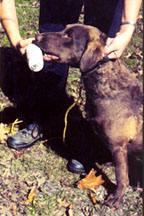
|
|
Preliminary: grasp the collar, force dummy into the dog's mouth while saying, "Fetch." |
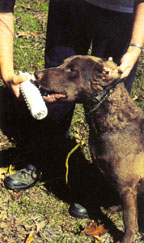
|
| Administering the ear pinch. |
A common and reasonable response to the sudden discomfort is resistance--the dog clamps its mouth shut. This is fine, except that you are going to keep up the pressure until you overcome the resistance. It may take a few seconds or over an hour. If resistance is prolonged, repeat, "fetch" in a calm voice at intervals to remind the dog that you are asking it to do something specific. When the clenched mouth slackens, quickly roll in the dummy.
Repetitions of this routine should quickly become easier. Continue to practice until the dog readily opens its mouth on command. Now you are ready to progress to what most people think of as force-fetching: the ear pinch.
Hold the dummy in front of the dog's mouth. Say "fetch" while pressing the dummy against its lips and pinching its ear. If the dog opens its mouth, roll the dummy in and quickly let off the ear pressure as you do. Praise it. You want it to get the idea that the ear-pinch means, "get that dummy in your mouth!"
If the dog clenches its mouth shut, you may be in for another extended session. Keep pinching and press the dummy harder against the dog's lips. Repeat "fetch." Again, keep your voice calm. If several minutes pass and the dog still does not open its mouth, get out the shotshell. Try pinching the ear between the metal casing and the collar, even the buckle on the collar. Persist! Eventually, the dog will give in and open its mouth. Be ready, roll that dummy in, stop the ear pressure, and praise the dog.
Fortunately, you usually don't have to fight this battle more than once (perhaps because the ear is getting tender, or the dog has decided it isn't worth it). After a fetch command, the dog (not you) should be holding the dummy. Tell it to "leave it" as you take it away.
If your dog resists opening its mouth, just do 10-15 repetitions and end the session. If it complies readily, then after a few repetitions pinch its ear and say, "fetch," but hold the dummy still and maintain ear pressure. Use your hold on the buckle collar to force the dog's head forward. As soon as the dog's mouth is approximately around the dummy, release the pressure. The command now means, "reach forward and take the dummy." Repeat.
As it starts to get the idea, stop pushing its head forward. You want the forward momentum to come from the dog. Soon it will try to grab the dummy before you can pinch it. Hold it back by the collar until you give the command. As when we restrain young dogs on marks, this restraint will increase its forward drive.
Start mixing in instances where you give the command and stop restraining the dog, but do not pinch the ear. Try not to be predictable about when you do and do not pinch--maybe pinch twice in a row, then do three fetches with no pinch. You want the dog to think that it is "beating the pinch" by getting the dummy fast. Any time it is slow, pinch! Now you can use a new standard for knowing when it is time to progress: if the dog is reliable at one level after several repetitions without a pinch, it is probably ready to move on.
Start holding the dummy four or five inches in front of the dog when you say "fetch." When it is solid reaching this far, hold the dummy farther forward. Soon it will have to stand up in order to reach far enough. Now tell it to "hold," then "sit" with the dummy before telling it to "leave it." If you restrain it by holding the collar, it should start lunging aggressively for the dummy when released. If it doesn't, you may be trying to advance too fast--back up and work on a shorter reach. Be sure you are in position with your hold on collar and ear every time you give the command, whether you plan to pinch or not.
When your dog will lunge three feet and grab the dummy, whether you pinch its ear or not, you are ready to move on.
If your dog is one that totally balks at picking the dummy up off the ground, and you have tried going back to review previous steps, you might make some headway by giving in a little. Toss a dummy forward far enough to be a short freebie and release the dog. Repeat but say "fetch" as you release it. Repeat, shortening the distance--approaching the problem from the opposite direction, as it were. Sometimes simply kicking the dummy to move it forward a little is all that is needed. Intuitively it seems as though the dog must be forced through every part of this procedure, but experience shows that relenting a little at this point may be just as effective.
Some dogs will not respond to "easing up" with a short throw, but will squeal, thrash around, and direct their efforts to escaping the ear pinch by every possible means except getting the dummy. As mentioned previously, it is important not to establish a pattern of struggling with the dog physically. If you cannot physically restrain the dog, increasing the pressure may do the trick. You can press the dog's ear with a shotshell instead of your thumb; even get a studded collar and pinch the ear against that. Make the dog's need to stop the pinching so urgent that resisting your will fades in importance.
While many Labrador and Golden retrievers can be accelerated through force-fetch by using heavy pressure from the beginning, we do not recommend that inexperienced trainers use this heavy-handed approach. If you cannot reliably tell when the dog understands for sure what is expected, pressure becomes mere abuse. The cost to the dog's confidence, in you and in its work, is great.
By the time this issue is resolved, most dogs will dive on the dummy when you say, "fetch," but many will fumble it, lie down, or just be very slow to come up with it. This is continued resistance to your increasing authority, and the job is not done until it is overcome. As your dog lunges forward toward the dummy, move forward yourself so the dog remains in heel position. As soon as its jaws reach the dummy, pull its head up with your hand on the collar. This works best if you continue moving forward a step or two past where the dummy was lying. If the dog drops the dummy, correct--use a chuck under the chin or pinch its ear and place the dummy in its mouth. If it doesn't make rapid progress, you can increase the pressure by requiring it to pick up the dropped dummy (stay on the ear until it does).
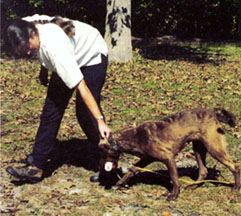
|
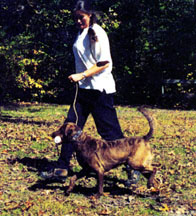
|
|
Pull the dog's head forward and up to develop a quick pick-up. The thumb is ready if the dog fumbles and drops the dummy. |
Reviewing with movement helps maintain a good attitude |
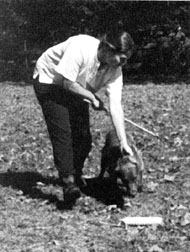
|
|
Stick fetch. By now the dog is lunging for the dummy. |
Get a stick 30- or 40-inches long. You can have a helper wield the stick, or do it yourself. Don't make the stick any more obvious than it has to be. With the dog at heel, toss the dummy about three feet in front of the dog. With your hand on the collar and ear, say, "fetch." Immediately tap the dog on the hindquarters with the stick. Repeat "fetch" and pinch the ear all the way to the dummy. Repeat, varying how hard you hit the dog, sometimes not hitting it. Again, you want to make the dog think that by going fast it can avoid the stick. As it catches on, try using the stick and no ear pinch. Usually not many sessions are needed (maybe 3-6). When the dog is digging out to beat the stick and seems totally reliable without any ear pinch, you are finished--you have successfully force-fetched your retriever.
Many trainers follow force-fetching with a "walking fetch" drill where several dummies are lying on the ground, ten feet or more apart. Trainer approaches dummies with dog at heel and says, "fetch" as dog's attention focuses on the first dummy. Any refusals are corrected with the ear pinch. After the dog sits to deliver, the trainer can drop the dummy behind the dog for a later circuit. When performance is smooth, the stick can be added just as in the fetch from a sitting position. If the previous steps have been carefully done, the dog will soon be lunging eagerly for each dummy as soon as it sees it.
We then work on getting the dog to wait until it is commanded to "fetch," using repeated "heel" commands and jerks on the lead. Generally we don't pursue this to the point where it is absolute--the dog's getting the idea is enough. Not all youngsters can take heavy drilling on contradictory ideas such as "go" and "don't go."
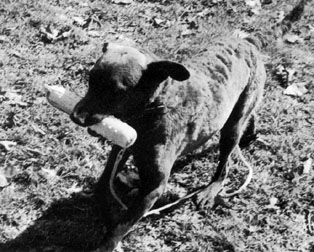
|
| "Happy bumpers" can also be good for the dog's attitude. |
Oak Hill Kennel, Pinehurst, NC (910) 295-6710
Copyright © 1998 Oak Hill Kennel